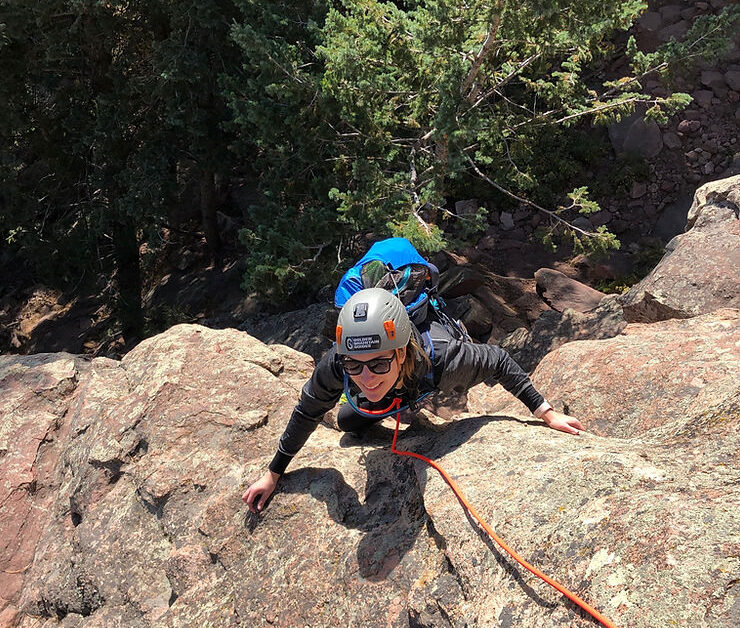
All smiles after pulling through the crux on Bakers Way, 5.3
It’s official: The Boulder Flatirons are an awesome place to climb. Look to the west from downtown and you will find no shortage of rock fins that ignite the imagination, mountains that inspire, and endless climbing opportunities. Rising almost 1,100 feet out of Boulder, these incredible formation provide a lifetime of climbing, hiking, and sightseeing opportunities within a few minutes drive from Pearl Street. Some of the best beginner rock climbs in the whole country reside on these east facing slabs, and are technically easy and straightforward climbing adventures that offer immense enjoyment.
I bet you’ve always wanted to climb a Flatiron…it’s easy to see why! Incredible views, great climbing, and breathtaking summits are only a few of the reasons to rope up here. These are big climbing routes and you should be up for a challenge and a longer day out in the mountains. There is a lot to know about climbing a Flatiron, but I know you’re up to the challenge! As with any day out rock climbing, there is a lot to know, but if you are planning on climbing one of the Flatirons, the most important things are:
Logistics
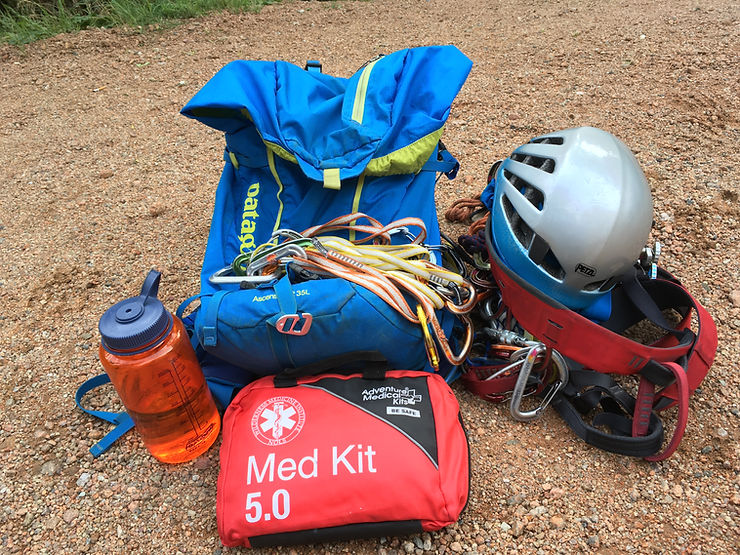
What should I bring when planning to climb a Flatiron?
This is the big one! For many, the logistics of climbing a Flatiron can seem overwhelming. I can’t tell you the number of times I see people carrying way too much gear and not tagging the summit. Let’s keep it simple and split logistics into three categories: 1) Gear, 2) Approach and Descent, and 3) Climbing.
Gear –
My recommendation on gear for the Flatirons is based on well over 200 successful summit attempts and I’ve boiled down exactly what gear to bring. If you are newer to climbing big trad routes, I always encourage being conservative and tossing in a few extra pieces. Be prepared to build your own trad anchors, even if you plan on going up the Third Flatiron. But remember, the bigger your backpack, the more weight you’ll have on your calf muscles throughout the day!
What I typically carry for a climb in the Flatirons:
– Rain jacket (while I don’t use this layer very often, it is reassuring to know that I have it just in case)
– First aid kit
– 1 liter of water (I have always found this adequate for a Flatiron, even when it’s hot. Just make sure to hydrate properly the day before)
– Belay gloves
– 6 to 10 shoulder length runners, nylon or dyneema (this all depends on the route and I typically find myself carrying 6 more often than not)
– A single set of cams from .3 to 3 (I like Metolius Mastercams for the smaller sizes and Black Diamond camalots for .5 and bigger)
– 2 stoppers (I carry the DMM gold and blue offset nuts)
– 1 nut tool
– 1 quadruple length dyneema runner
– 1 20 foot piece of 6 or 7mm cordellette
– 5 locking carabiners (Pear shaped lockers are always easier to work with than D shaped ones)
– Belay device
– 1 shoulder length nylon sling for a rappel extension
– Sterling Hollowblock or other cordellette for friction hitches
– 60m dyanamic climbing rope (I like 9.4mm bi-patterns the best)
– 20 liter backpack
– Approach shoes with sticky climbing rubber
– Comfortable rock climbing shoes
– Helmet
– High energy foods (my all-time favorite is cold pizza!)
Approach and Descent –
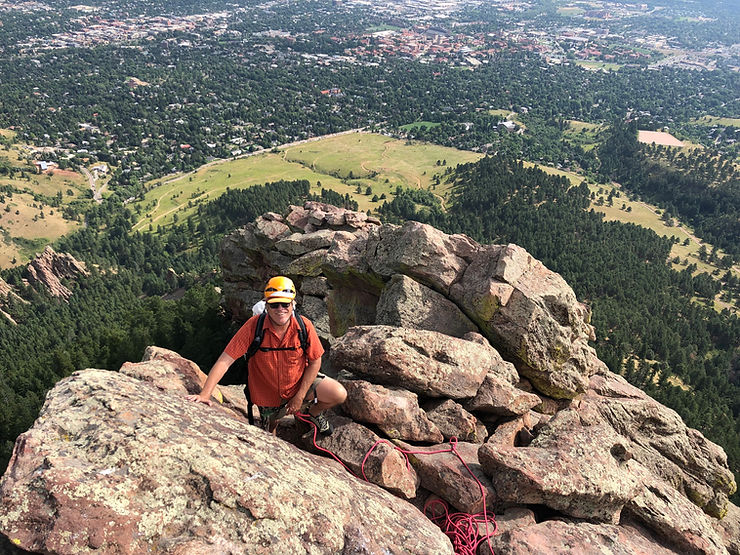
Climbing is only half the battle…don’t get lost on the hike
The best approach to the First, Second, and Third Flatirons is from the Chautauqua Park Ranger’s Cabin, located on 9th and Baseline. There is ample parking here if you get an early start, however, it does fill up very quickly during the summer. The City of Boulder does charge a parking fee from Memorial Day to Labor Day to park here. If you are looking for a cheaper alternative, try the free shuttle bus that picks up from New Vista High School.
From the Ranger’s Cabin, it’s best to take the Bluebell Road south towards the Bluebell Shelter, until you can head back west on the clearly marked Bluebell-Baird Trail. Take this to the junction and you will see a sign for the 1st/2nd Flatiron Trail. Continue west to climb the First, or back south along this trail for the Second or Third. This is a little shorter of a hike than heading straight up the Chautauqua Trail. Expect about 2.5 miles of hiking.

Boulder OSMP has a cool interactive trail map. Click the picture to check it out!
The best descent from the Third Flatiron involves 3 rappels with a 60m rope. Many people do this in only 2 rappels, however, it makes pulling the rope incredibly difficult. From the summit, look south and find the two bolt rappel station and make a short rappel (~50 feet) to a large ledge. From the ledge, look south and find a two bolt anchor and make another short rappel (~50 feet) to a well defined ledge. Look to the left and you will see two different anchors on this ledge. Rappel off of the far left bolt/chains for about 80 feet to the ground.
The best descent from the Second Flatiron is to walk off the back! This is an easy one to get off of as the top intersects the First/Second hiking trail.
The best descent from the First Flatiron is a 30 meter rappel off the back from a two bolt anchor. You can definitely make the ground with a 60 meter rope.
Seasonal Closures
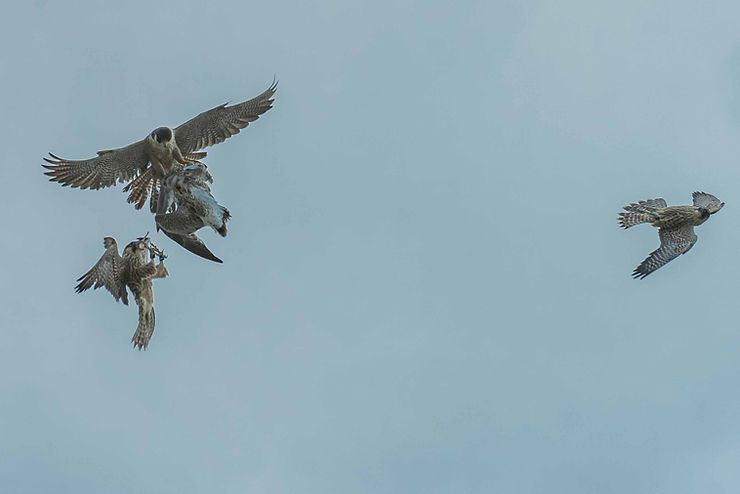
Respect these beautiful birds!
To protect birds of prey, Boulder Open Space closes access to the Third Flatiron, along with many other formations, from February 1st through July 31st. Peregrine Falcons make their nests here and do not respond well to human interaction during nesting season. Please respect the closures and keep our access open. During this time, it is best to climb the First or Second Flatirons. A full list of the seasonal closures can be found HERE. Another great resource for the seasonal closures is the Flatirons Climbing Council.
Flatirons Climbing
Climbing in the Flatirons can be quite a unique experience. The rock is Fountain Sandstone and the formations tend to be on the slabby side. Protecting these routes can sometimes be dubious and runout. Even though the climbing is relatively straightforward, you may be looking at runouts of 40 feet or more between good gear. The first pitch of the Direct Route on the First Flatiron is almost 200 feet long and only has 4 pieces of pro for the entire pitch! If you plan to climb here, it’s best to be a solid trad leader with a good lead head. It’s also best to climb a lot of shorter pitches to alleviate any communication issues. If leading a Flatiron is one of your goals, check out this Blog Post on setting goals for climbing.
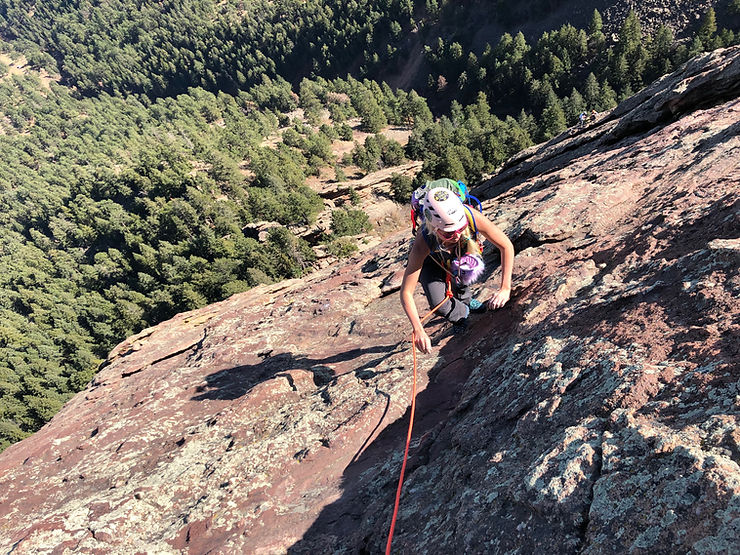
Getting close to the summit of the Third Flatiron
Climbing in the Flatirons can be quite crowded on some days. It is always best to have a few different backup routes in mind in case the queue line has started for form. I am also a big fan of early start times to beat the crowds! Some of my absolute favorite routes are:
– Baker’s Way, 5.3
– Fandango, 5.6
– North Arete, 5.4
– Direct Route, 5.6
– Freeway, 5.2
– East Face, 5.4
Weather in the Flatirons
The weather in Colorado can change rapidly. Always check the weather forecast before you climb and come prepared for the unexpected. Many times, weather rolls in from the west and is not visible until you summit. These formations are east facing and get a lot of sun. Climbing here can heat up very quick and can literally roast you. Early starts are always good. Climbing here when the rock is wet can be hazardous.
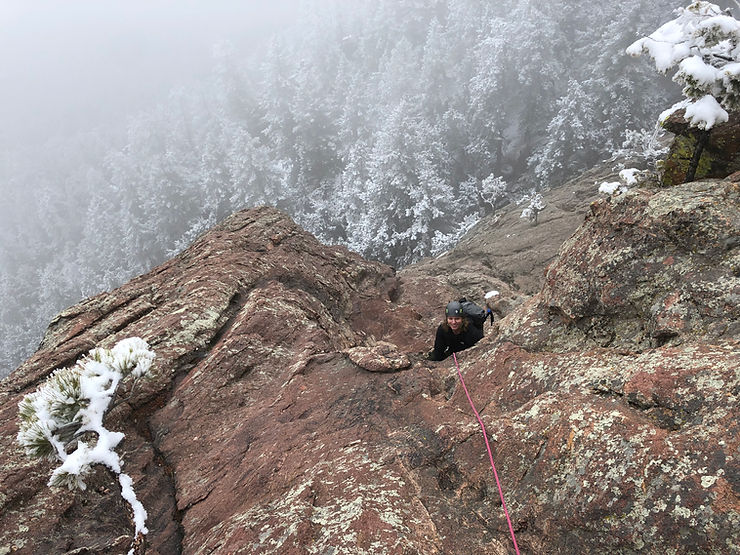
Be prepared for the weather!
So you are still psyched on climbing a Flatiron? Get out there and do it! Check the weather, get your gear and logistics together, check for seasonal closures, and work your way up to leading a Flatiron. Not sure where to begin with something like this? Check out Our Website for more information on guided trips up the Boulder Flatirons or other iconic Colorado climbs. I hope to see you out there!


Content Copyright © 2024 of Golden Mountain Guides. All rights reserved. | Privacy Policy | Site Map